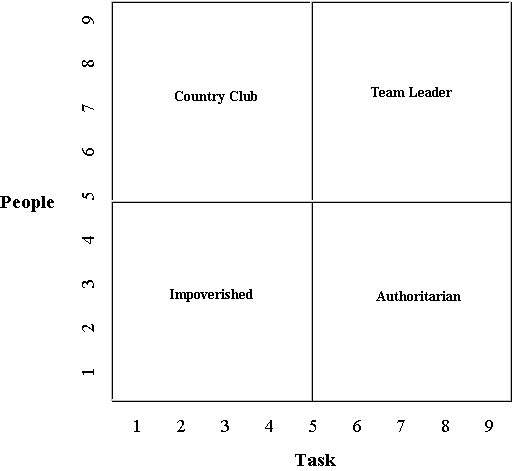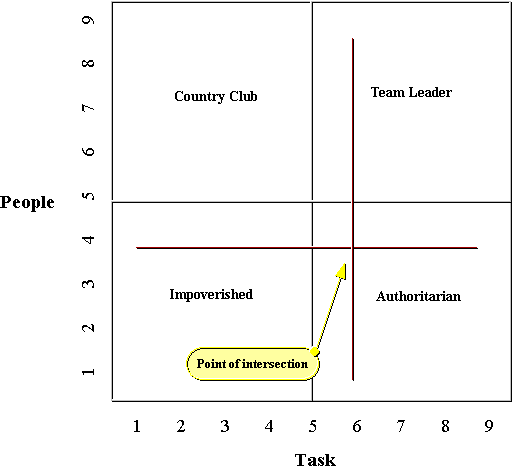
Abilities
Arousal
Attitude
Behavior
Beliefs
Competencies
Engagement
Environment
EI
Experience
Feelings
Intention
Motivation
Nature and genes
Organization
Performance
Performance Improvement
Performers
Process
Results
Skills
Social Pressure
Talent
Understanding
Values
Objective: To determine the degree that a person likes working with tasks and people.
Time: 45 Minutes
Have the
learners complete the 18 items in the Questionnaire section.
Next, have them transfer their answers to the two respective columns
provided in the scoring section. Total the score in each column and
multiply each total by 0.2. For example, in the first column (People),
if the learner answered 5, 3, 4, 4, 3, 2, 5, 4, 3 then his or her final
score is = 33 X 0.2 = 6.6.
The total score for the fist column (people) is plotted on vertical
axis in the matrix section, while the total score for the second column
(Task) is plotted on the horizontal axis. For a sample, see Example.
Finally, have the learners intersect the lines to see in what leadership
dimension they normally operate out of:
- Authoritarian
- Impoverished
- Team Leader
- Country Club
Questionnaire
Below is a list of statements about leadership behavior. Read each one carefully, then, using the following scale, decide the extent to which it actually applies to you. For best results, answer as truthfully as possible.
never |
sometimes |
always |
|||
0 |
1 |
2 |
3 |
4 |
5 |
01. ____ I encourage my team to participate when it comes decision making time and I try to implement their ideas and suggestions.
02. ____ Nothing is more important than accomplishing a goal or task.
03. ____ I closely monitor the schedule to ensure a task or project will be completed in time.
04. ____ I enjoy coaching people on new tasks and procedures.
05. ____ The more challenging a task is, the more I enjoy it.
06. ____ I encourage my employees to be creative about their job.
07. ____ When seeing a complex task through to completion, I ensure that every detail is accounted for.
08. ____ I find it easy to carry out several complicated tasks at the same time.
09. ___ I enjoy reading articles, books, and journals about training, leadership, and psychology; and then putting what I have read into action.
10. ____ When correcting mistakes, I do not worry about jeopardizing relationships.
11. ____ I manage my time very efficiently.
12. ____ I enjoy explaining the intricacies and details of a complex task or project to my employees.
13. ____ Breaking large projects into small manageable tasks is second nature to me.
14. ____ Nothing is more important than building a great team.
15. ____ I enjoy analyzing problems.
16. ____ I honor other people's boundaries.
17. ____ Counseling my employees to improve their performance or behavior is second nature to me.
18. ____ I enjoy reading articles, books, and trade journals about my profession; and then implementing the new procedures I have learned.
Scoring Section
After completing
the Questionnaire, transfer your answers to the spaces below:
| People | Task |
| Question | Question |
| 1. ________________ | 2. ________________ |
| 4. ________________ | 3. ________________ |
| 6. ________________ | 5. ________________ |
| 9. ________________ | 7. ________________ |
| 10. _______________ | 8. ________________ |
| 12. _______________ | 11. _______________ |
| 14. _______________ | 13. _______________ |
| 16. _______________ | 15. _______________ |
| 17. _______________ | 18. _______________ |
| TOTAL ___________ | TOTAL ___________ |
| X 0.2 = ___________ | X 0.2 = ___________ |
| (multiple the Total by 0.2 to get your final score) | (multiple
the Total by 0.2 to get your final score)
|
Matrix Section
Plot your final scores on the graph below by drawing a horizontal line from the approximate people score (vertical axis) to the right of the matrix, and drawing a vertical line from the approximate task score on the horizontal axis to the top of the matrix. Then, draw two lines from each dot until they intersect. The area of intersection is the leadership dimension that you operate out of.
Example
The Results
This chart
will give you an idea of your leadership style. But, like any other
instrument that attempts to profile a person, you have to take in other
factors, such as, how your manager and employees rate you as a leader,
do you get your job done, do you take care of your employees, are you
helping to "grow" your organization, etc.
You should review the statements in the survey and reflect on the low
scores by asking yourself, "If I scored higher in that area, would
I be a more effective leader?" And if the answer is yes, then it
should become a personal action item.
People and Mission
Some may ask, "In order to get a perfect score I would have to max out statements 2 (Nothing is more important than accomplishing a goal or task) and 14 (Nothing is more important than building a great team), but this would be a paradox."
One of the mottos of the U.S.Army is "People and mission first". It means nothing is more important than accomplishing the mission and nothing is more important than looking out for the welfare of the people. A good leader can do both.
Relationships With Others
For statement 10 (When correcting mistakes, I do not worry about jeopardizing relationships), some people might believe that a "people-person" would put a low score to this question. They might believe that a "people-oriented" person would not want to jeopardize a relationship. However, if a leader really cared about the person, would the relationship (being friends) be more important or would guiding the person on to the correct behavior be more important? Lets put it in a "leader" relationship - If you did not correct your learner's mistakes, would that make you a better person? Probably not. Good leaders do what it takes to build and develop the people around them. The "relationship" is not what makes them tick, rather it is more about helping others to grow.
This question helps to separate the "country club leaders" who want to be friends with everyone; the "impoverish leaders" who are afraid they might make waves; and the real "leaders" who are more concerned with coaching others so that they become a valued member of the team. That is, if the leader lets one of her peers continue with the incorrect behavior, does this help or hinder the other members of the team? It is best not to picture a leader as a friend, but as a person who is concerned with the growth and welfare of others.
Self Assessment
Can people
assess themselves? For studies, see Learner and Self Ratings.
A perfect score is a nine in both categories of People and Tasks. If
you gave yourself a perfect score or close to it, you are being too
easy on yourself - you cannot learn if you do not take a Critical Self
Reflection of yourself.
Modeling
For more
information on constructing models of this nature, see Modeling.
Reliability and Validity
Since this survey is a training tool, it has not been formally checked
for reliability or validity. However, since I have had a lot of feedback
from various training classes, other trainers, and various sources,
I feel that it is fairly accurate.

